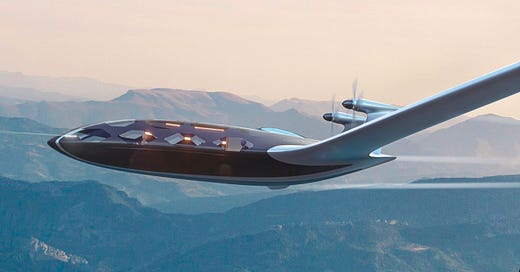Pioneering a New Era in Aviation: Introducing the EE-19 Hybrid Electric Blended Wing Body (BWB) Airliner
Your Weekly Shortcut to Deeptech Investing—Exclusive Trends & Startup Reports for VCs & Angels in Just 5 Minutes
By Gael Amouyal, Deeptech Expert
What is going on?
Among the exciting innovations showcased at this year's Paris Air Show is the EE-19 hybrid electric blended wing body (BWB) airliner concept from EENUEE. With its futuristic design and groundbreaking technology, the EE-19 represents a significant leap forward in aviation. This article explores the key features and potential benefits of this remarkable aircraft.
The Concept of the Blended Wing Body (BWB).
The blended wing body (BWB) concept has been the subject of interest and research in the aerospace industry for many years. Unlike conventional aircraft designs, the BWB eliminates the clear distinction between the fuselage and wings, creating a seamless integration of the two. This unique shape offers several advantages, such as increased fuel efficiency, improved aerodynamics, and enhanced payload capacity.
What does it mean?
The EE-19 Hybrid Electric BWB Airliner Concept
The EE-19, developed by EENUEE, takes the BWB concept to the next level by integrating hybrid electric propulsion. This forward-thinking approach aligns with the industry's commitment to sustainable aviation and reducing carbon emissions.
Key Features and Advantages:
1. Enhanced Efficiency: The EE-19's blended wing design reduces drag and improves fuel efficiency by up to 20% compared to traditional airliners. The aircraft's shape allows for smoother airflow over the wings and fuselage, resulting in reduced fuel consumption and lower operating costs.
2. Increased Passenger Capacity: The unique design of the EE-19 enables a wider cabin space, maximizing passenger capacity. By utilizing the entire airframe for seating, the aircraft can accommodate more passengers without compromising comfort or safety.
3. Reduced Noise Pollution: The BWB configuration significantly reduces noise emissions, both inside and outside the aircraft. The engines' positioning on top of the wings helps shield noise from reaching the ground, minimizing the aircraft's noise footprint near airports and surrounding communities.
4. Hybrid Electric Propulsion: The EE-19 incorporates hybrid electric propulsion, combining traditional jet engines with electric motors. This hybrid system provides numerous advantages, including reduced fuel consumption, lower carbon emissions, and quieter takeoffs and landings.
5. Enhanced Range and Versatility: The EE-19's efficient design and hybrid propulsion system enable extended range capabilities. The aircraft can efficiently travel longer distances without the need for refueling, opening up new possibilities for non-stop routes and improved connectivity between cities.
Why does it matter?
💸For markets: Financial Market Opportunities Soar with Blended Wing Body Airliners
The introduction of blended wing body (BWB) airliners like the EE-19 concept has the potential to positively impact the financial market. With increased fuel efficiency, airlines can save on operating expenses, leading to improved profit margins. The BWB's larger passenger capacity also allows for higher revenue potential. Furthermore, as sustainability becomes increasingly important, BWB aircraft with hybrid electric propulsion systems can provide a market advantage, appealing to environmentally conscious travelers and aligning with regulatory requirements. Overall, the financial market for BWB airliners offers opportunities for cost savings, revenue growth, and competitive differentiation for airlines.
🧑🏿🤝🧑🏻For society: The Future of Sustainable Aviation
The EE-19 hybrid electric BWB airliner concept represents a glimpse into the future of sustainable aviation. As the world becomes increasingly concerned about climate change and environmental impact, the aviation industry is taking significant steps toward greener technologies. EENUEE's innovative approach with the EE-19 demonstrates a commitment to reducing carbon emissions while simultaneously improving efficiency and passenger experience.
🔮What’s next? Challenges and Future Prospects
While the EE-19 holds great promise, there are challenges to overcome before it becomes a reality. Integrating hybrid electric propulsion on a large scale and ensuring the necessary infrastructure for electric aircraft are significant hurdles. Additionally, regulatory frameworks and certification processes must adapt to accommodate these new technologies.
However, as the aviation industry continues to invest in research and development, advancements in battery technology and charging infrastructure are expected. With ongoing innovation and collaboration, the potential for hybrid electric blended wing body airliners like the EE-19 to become a common sight in our skies is within reach.
✨ That’s all for today. Thanks for reading !
💖Like, follow and subscribe to our Community ! Stay tuned for our next Deeptech Analysis coming up end of the week with our Deeptech Insights Newsletter.
Much love Deeptechers!👋




